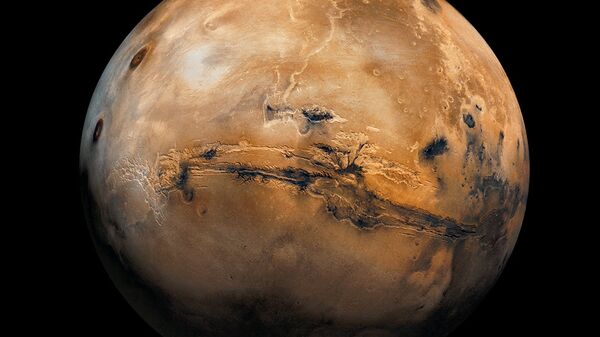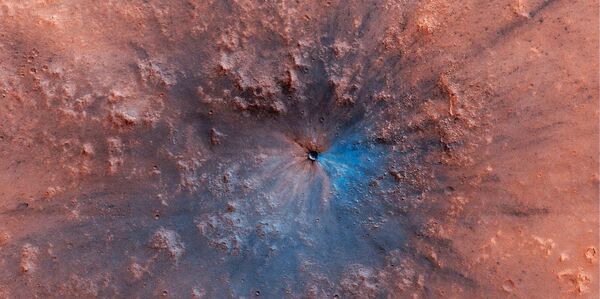NASA's Mars Reconnaissance Orbiter has snapped what is thought to be a freshly-formed 49-53 foot-wide crater on the surface of the planet which astronomers say is like nothing they've ever seen before.
The image, taken by the orbiter's onboard high resolution camera equipment 255 km above the planet in the Valles Marineris, near Mars' equator, was taken in April, and posted on the High Resolution Imaging Science Experiment (HiRISE) website earlier this month.
The colour image's unique black-and-blue hue, set against the backdrop of the Red Planet, has left scientists intrigued. "What makes this stand out is the darker material exposed beneath the reddish dust," the HiRISE's website noted, emphasizing that the crater was a real "work of art."
According to HiRISE team member Veronica Bray, the object which impacted the planet to form the crater was likely about 5 feet wide, and composed of a denser rock, given its impact without first breaking into multiple pieces over the atmosphere.
The size of the crater compared to the object's size also gives some indication of the tremendous force with which it slammed into the planet.
"It's a reminder of what's out there," Bray said, speaking to Space.com. "It's a gorgeous [crater]. I'm glad I got it in the colour strip," she added.
According to the scientist, the dark zone in the photo indicates the area where dust was shifted off the surface. The bluish tint may or may not indicate exposed ice previously hidden under the Martian dust.
Peter Grindrod, a planetary scientist at the London Natural History Museum, said he was "blown away" by the image. "I'd never seen anything like that," he said, referring to the crater's size. The scientist tweeted two side-by-side satellite images of the location before and after the strike.
KABOOM! Before and after images of a meteorite forming a brand new impact crater on Mars. Sometime between 18 Feb 2017 and 20 March 2019. pic.twitter.com/TWXtUoP5NA
— Peter Grindrod (@Peter_Grindrod) June 12, 2019
Social media users were similarly enamored with the spectacular find, with some wondering whether instead of a space rock, the crater may have been left by a dead Martian satellite, a faction from some science fiction series, or, of course, ancient aliens.
Probably one of the dead satellites that went DOA when they got to Mars.
— (((Ken)))🍀 (@kendp) June 17, 2019
That or Aliens - the Ancient ones
Uh-oh, somebody's been having too much fun with some Omega molecules....
— TrekCore.com 🖖 (@TrekCore) June 18, 2019
(New Mars impact crater image from @HiRISE orbiter: https://t.co/DpSHjaLr7j) #StarTrek pic.twitter.com/Q4ZkWTQLFT
Whether we wanted it or not, we've stepped into a war with the Cabal on Mars. So let's get to taking out their command, one by one. Valus Ta'aurc. From what I can gather, he commands the Siege Dancers from an Imperial Land Tank just outside of Rubicon.
— Polo Lil-Smokey (@h2opoloplyr_11) June 18, 2019
The photo is very real, the object unfortunately landed on a member of The Blue Man Group
— Mr. Morefun (@Mr_Morefun) June 17, 2019
Others simply made crude jokes about the crater's distinct shape, which they said reminded them of a certain part of the mammalian anatomy.
I thought it was Uranus
— Chad (@Koifla) June 17, 2019
This seems like an awfully familiar crater 🤔🤔🤔... pic.twitter.com/X1zkrqIwHH
— One_Mo_Wish (@OneWish) June 17, 2019
That’s actually the official name
— Simon Stålenhag (@simonstalenhag) June 17, 2019
Mars is bashed by over 200 asteroids and comets every year. NASA's Mars Reconnaissance Orbiter is one of several man-made space probes orbiting the planet, and has been in operation since 2005.




